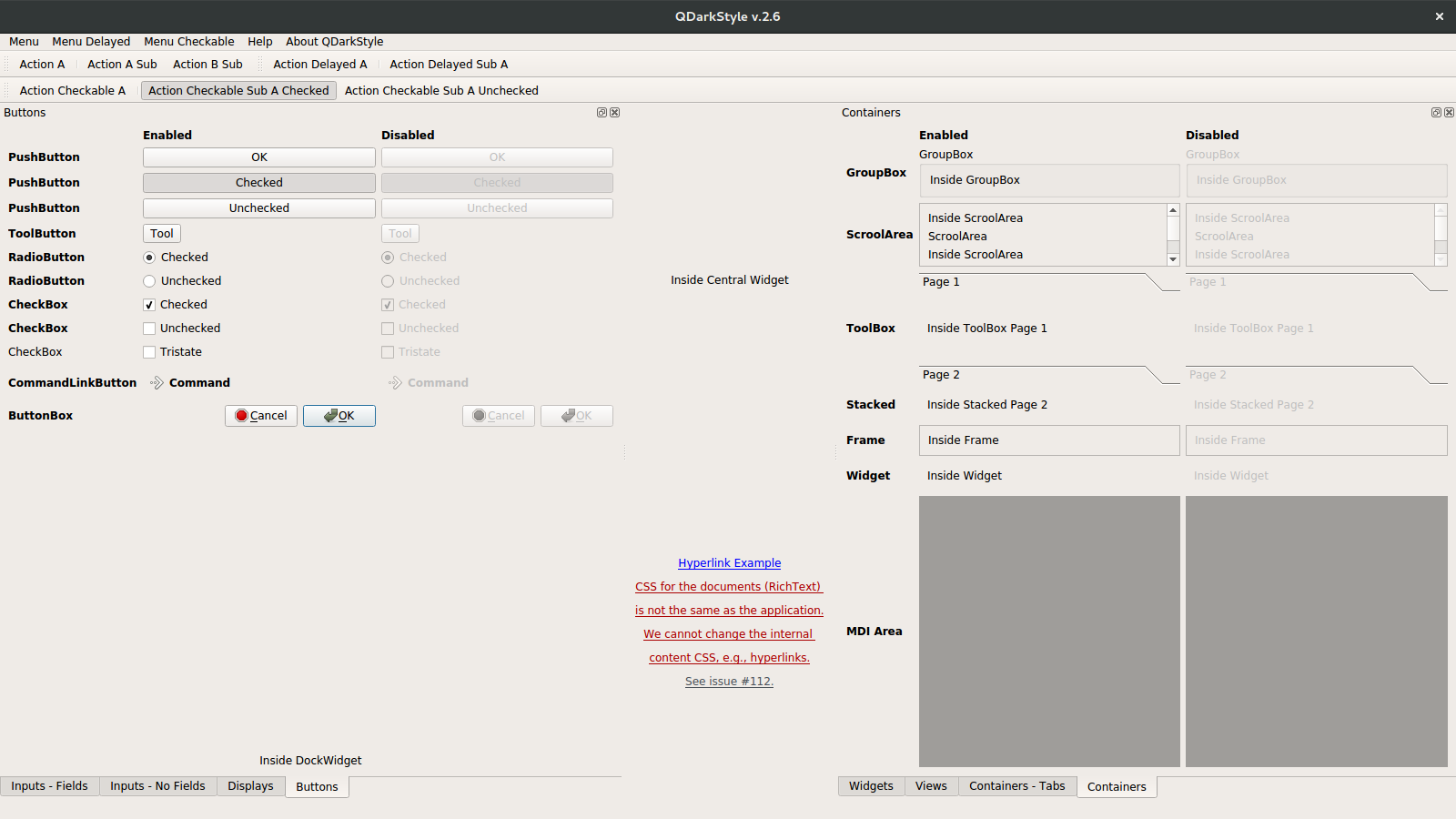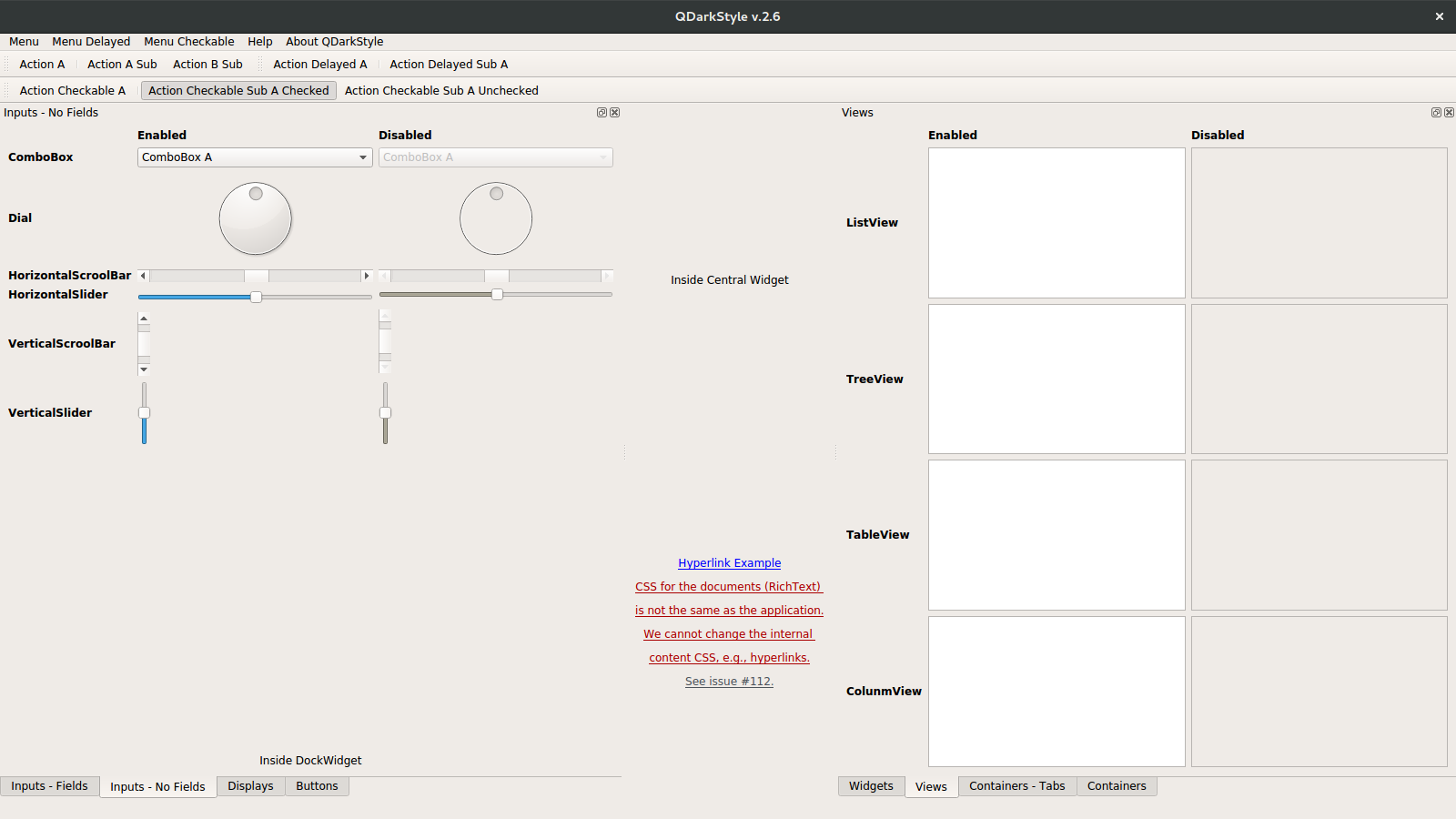# QDarkStylesheet
[](https://travis-ci.org/ColinDuquesnoy/QDarkStyleSheet)
[](https://pypi.python.org/pypi/QDarkStyle)
[](https://opensource.org/licenses/MIT)
[](https://creativecommons.org/licenses/by/4.0/)
[](http://contributor-covenant.org/version/1/4/)
A dark stylesheet for Qt applications (Qt4, Qt5, PySide, PySide2, PyQt4, PyQt5, QtPy,
PyQtGraph).
## Installation
### Python
From PyPI: Get the latest stable version of ``qdarkstyle`` package
using *pip* (preferable):
```bash
pip install qdarkstyle
```
From code: Download/clone the project, go to ``qdarkstyle`` folder then:
- You can use the *setup* script and pip install.
```bash
pip install .
```
- Or, you can use the *setup* script with Python:
```bash
python setup.py install
```
### C++
- Download/clone the project and copy the following files to your application
directory (keep the existing directory hierarchy):
- **qdarkstyle/style.qss**
- **qdarkstyle/style.qrc**
- **qdarkstyle/rc/** (the whole directory)
- Add **qdarkstyle/style.qrc** to your **.pro file** as follows:
```cpp
RESOURCES += qdarkstyle/style.qrc
```
- Load the stylesheet:
```cpp
QFile f(":qdarkstyle/style.qss");
if (!f.exists())
{
printf("Unable to set stylesheet, file not found\n");
}
else
{
f.open(QFile::ReadOnly | QFile::Text);
QTextStream ts(&f);
qApp->setStyleSheet(ts.readAll());
}
```
_Note: The ":" in the file name is necessary to define that file as a resource library. For more information see the discussion [here](https://github.com/ColinDuquesnoy/QDarkStyleSheet/pull/87)._
## Usage
Here is an example using PySide
```Python
import sys
import qdarkstyle
from PySide import QtGui
# create the application and the main window
app = QtGui.QApplication(sys.argv)
window = QtGui.QMainWindow()
# setup stylesheet
app.setStyleSheet(qdarkstyle.load_stylesheet_pyside())
# run
window.show()
app.exec_()
```
To use another wrapper for Qt, you need to replace some lines.
See examples below.
To use PyQt4, change two lines
```Python
from PySide import QtGui
app.setStyleSheet(qdarkstyle.load_stylesheet_pyqt())
```
If PyQt5, more lines need to be changed because of its API,
see the complete example
```Python
import sys
import qdarkstyle
from PyQt5 import QtWidgets
# create the application and the main window
app = QtWidgets.QApplication(sys.argv)
window = QtWidgets.QMainWindow()
# setup stylesheet
app.setStyleSheet(qdarkstyle.load_stylesheet_pyqt5())
# run
window.show()
app.exec_()
```
If your project uses QtPy or you need to set it programmatically,
it is far more simple
```Python
import sys
import qdarkstyle
import os
# set the environment variable to use a specific wrapper
# it can be set to pyqt, pyqt5, pyside or pyside2 (not implemented yet)
# you do not need to use QtPy to set this variable
os.environ['QT_API'] = 'pyqt'
# import from QtPy instead of doing it directly
# note that QtPy always uses PyQt5 API
from qtpy import QtWidgets
# create the application and the main window
app = QtWidgets.QApplication(sys.argv)
window = QtWidgets.QMainWindow()
# setup stylesheet
app.setStyleSheet(qdarkstyle.load_stylesheet_from_environment())
# run
window.show()
app.exec_()
```
It is also simple if you use PyQtGraph
```Python
import sys
import qdarkstyle
import os
# set the environment variable to use a specific wrapper
# it can be set to PyQt, PyQt5, PySide or PySide2 (not implemented yet)
os.environ['PYQTGRAPH_QT_LIB'] = 'PyQt'
# import from pyqtgraph instead of doing it directly
# note that PyQtGraph always uses PyQt4 API
from pyqtgraph.Qt import QtGui
# create the application and the main window
app = QtGui.QApplication(sys.argv)
window = QtGui.QMainWindow()
# setup stylesheet
app.setStyleSheet(qdarkstyle.load_stylesheet_from_environment(is_pyqtgraph=True))
# run
window.show()
app.exec_()
```
If you are using Qt.py, which is different from qtpy, you should install
qtpy then set both to the same binding.
_There is an example included in the *example* folder.
You can run the script without installing qdarkstyle. You only need to have
PySide or PySide2 or PyQt4 or PyQt5 installed on your system._
## What is new?
In the version 2.6, a reestructure stylesheet is provided. The palette has only 9 colors. Most widgets are revised and their styles were improved. We also provide a command line (script) to get info that could be used when opening issues. See the image below.
```
qdarkstyle --all
```
 ## Snapshots
Here are a few snapshots comparing the use of QDarkStyle v2.5.3 and the default style.
Click in the image to zoom.
## Snapshots
Here are a few snapshots comparing the use of QDarkStyle v2.5.3 and the default style.
Click in the image to zoom.
| Containers (no tabs) and Buttons |
 |
 |
| Containers (tabs) and Displays |
 |
 |
| Widgets and Inputs (with fields) |
 |
 |
| Views and Inputs (without fields) |
 |
 |
## Changelog
Please, see [CHANGES](CHANGES.md) file.
## License
This project is licensed under the MIT license.
Images contained in this project are licensed under CC-BY license.
For more information see [LICENSE](LICENSE.md) file.
## Authors
For more information see [AUTHORS](AUTHORS.md) file.
## Contributing
Most widgets have been styled. If you find a widget that has not been
style, just open an issue on the issue tracker or, better, submit a pull
request.
If you want to contribute, see [CONTRIBUTING](CONTRIBUTING.md) file.








 ## Snapshots
Here are a few snapshots comparing the use of QDarkStyle v2.5.3 and the default style.
Click in the image to zoom.
## Snapshots
Here are a few snapshots comparing the use of QDarkStyle v2.5.3 and the default style.
Click in the image to zoom.







